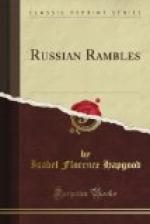Later on, the chief of police lived here, and the adjoining bridge, which had hitherto been known as the Green Bridge, had its name changed to the Police Bridge, which rather puzzling appellation it still bears.
A couple of blocks beyond this corner of the Nevsky, the Moika and the Grand Morskaya, the Nevsky Prospekt ends at the Alexander Garden, backed by the Admiralty and the Neva, after having passed in its course through all grades of society, from the monks at the extreme limit, peasant huts,—or something very like them, on the outskirts,—artistic and literary circles in the Peski quarter (the Sands), well-to-do merchants and nobles, officials and wealthy courtiers, until now we have reached the culminating point, where the Admiralty, Imperial Palace, and War Office complete the national group begun at the church.
When, in 1704, Peter the Great founded his beloved Admiralty, as the first building on the mainland then designed for such purposes as this, and not for residence, it was simply a shipyard, open to the Neva, and inclosed on three sides by low wooden structures, surrounded by stone-faced earthworks, moats, and palisades. Hither Peter was wont to come of a morning, after having routed his ministers out of bed to hold privy council at three and four o’clock, to superintend the work and to lend a hand himself. The first stone buildings were erected in 1726, after his death. In the early years of the present century, Alexander I. rebuilt this stately and graceful edifice, after the plans of the Russian architect Zakharoff, who created the beautiful tower adorned with Russian sculptures, crowned by a golden spire, in the centre of the immense facade, fourteen hundred feet long, which forms a feature inseparable from the vista of the Prospekt for the greater part of its length, to the turn at the Znamenskaya Square. On this spire, at the present day, flags and lanterns warn the inhabitants of low-lying districts in the capital of the rate at which the water is rising during inundations. In case of serious danger, the flags are reinforced by signal guns from the fortress. But in Peter I.’s day, these flags and guns bore exactly the opposite meaning to the unhappy nobles whom the energetic Emperor was trying to train into rough-weather sailors. To their trembling imaginations these signal orders to assemble for a practice sail signified, “Come out and be drowned!” since they were obliged to embark in the crafts too generously given to them by Peter, and cruise about until their leader (who delighted in a storm) saw fit to return. There is a story of one unhappy wight, who was honored by the presence aboard his craft of a very distinguished and very seasick Persian, making his first acquaintance with the pleasures of yachting, and who spent three days without food, tacking between Petersburg and Kronstadt, in the vain endeavor to effect a landing during rough weather.




